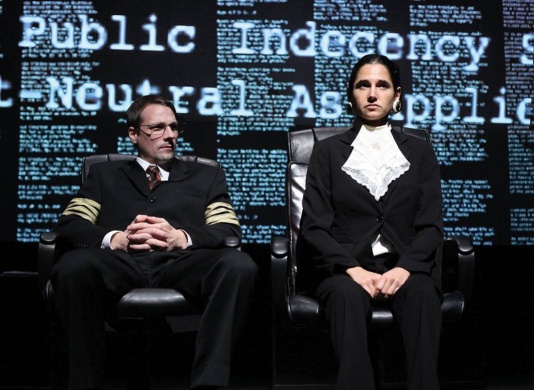Hello, world! So much has happened in the last two months. I moved to Ohio where I am attending Antioch College and exuberantly learning along with amazing people!
This week my Presence of the Performer class, taught by Gabrielle Civil, had an adventure from Yellow Springs to the Wexner Center in Columbus. We saw the Elevator Repair Service (a performance troupe from New York) perform Arguendo. If you’re in the area today, I would highly recommending taking the trek to see it. It is a very well-done performance and will change the way you think about the Supreme Court.
My review of the performance is below. Enjoy!

Life is But A Dance: Arguendo
The Elevator Repair Service’s performance of Arguendo was surprising, energetic and delightfully disturbing. The story that is told follows the Barnes vs. Glen Theatre Inc. Supreme Court Case. At first, the story is mild and dry, but before long, the performance is pulled in outrageous directions to bring up surprising comparisons between the Supreme Court, naked dancing, and what it means to be the interpreter of bewildering rules.
Though the performers’ actions were an iconic aspect of the performance, some of the strongest components of the piece were the technical aspects. The performance is set up very much like a play; the audience is confined in stadium-style seats and the stage (where the performers are contained) is directly in front of the audience. The stage consists of two ramps (which are later used as slides for rolling-chairs) and with a platform in back. The backdrop of the stage is a screen with projections that are constantly changing depending on the current situation of the live performers. At first the background is the hall of the Supreme Court, but soon it shifts to the text of the documents being cited in the performance. The iconic part of this background is the first-person interpretation that the audience sees. Depending on the way the characters are reading their physical sheets of paper (or what they’re doing in the moment), the text and images in the background changes. All of these movements are accompanied by a clicky-noise that adds to the drama of the movement. The backdrop almost acts as another performer because of this changing characteristic. Several times the audience reacted just to the physically comedic movement of the backdrop. Usually I don’t like the addition of unnecessary technical aspects in live theater because I think it can take away from the moment for the live performers, but in this case it worked very well.
The performers’ movement sequences were also dramatic and iconic. Though the five performers successfully played many different characters throughout the course of the performance, they all maintained jerky, comical, timed movements in every character. This contributed to the dream-like feel of the whole performance. It was obvious that lots of thought had gone to each specific movement of the piece. At several points during the play, the “judges” are in rolling chairs and the movements that they do turn in to a kind of dance. Lots of times the movements are also in tandem, which must have taken a lot of time to choreograph. As I looked in the program, I realized that there was aactually Movement Dramaturg, Katherine Profeta, who was the choreographer and researcher of all the movement. It was apparent that lots of time and energy went in to creating the movement of the piece; it was successful at making bits of the performance funny and well timed.
Each of the characters had successful and entertaining vocal characteristics. Subtle (and sometimes exaggerated) tones in their voices changed depending on the part they were portraying. I thought that portrayal of the lawyers in the piece was especially affective. Their numb and generic voices were hilarious and accurate.
As the performance progressed, the audiences learned more about the Barnes vs. Glen Theatre, Inc. case. When listening to a talkback with a retired professor of law, I realized that there were definitely people in the audience who were intrigued by the actual facts of the case. However, while watching, the facts of the case were subtle to me in comparison to the movement that was happening simultaneously.
I thought that the most insightful part of the performance was the way that all of the pieces of the story came together. The Barnes v. Glen Theatre, Inc. case deals with entertainment establishments that want their dancers to be able to perform in the nude, while an Indiana statute says that adult entertainers must wear at least a “G-string” and “pasties” when they perform. As the performance advances, the courtroom evolves from a typical bland courtroom to a chaotic blizzard of naked-dancer-lawyers and flying documents. The roles reverse as the judges and lawyers begin to strip and create their own disordered dance in the courtroom. Though I believe this was intended to be an exaggeration of the real courtroom, it was a parallel of what I think might really be going on at times. =

Very entertaining review, Hannah. You made me want to go see it FOR SURE. I just never put naked dancers and the supreme court in the same sentence before.